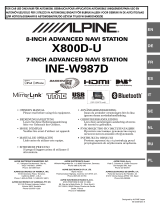
2-EN
01GB03PXAH800TOC.fm
ALPINE PXA-H800_EN 68-13530Z65-A (B5)
Use the Multi Channel Function
Setting the 2-Channel Signal Playback Mode
(2ch Playback Mode) ..................................30
Setting the 2-Channel Signal Playback Mode
(2ch Playback Mode) ...............................30
Setting EUPHONY (EUPHONY) ............... 30
Using Dolby Pro Logic II
(Dolby Pro Logic II) ................................ 31
Multi Channel Function Adjustment
Procedure ..................................................... 32
Multi Channel Setup .......................................32
Adjusting the Speaker Volume Level
(Output Level) ..........................................33
Adjusting the Acoustic Image
(BI-PHANTOM) ......................................33
Mixing the Low Range Audio for the Rear
(Rear Mix) ................................................ 33
Mixing the Low Range Audio of the Center
with the Front L/R (Center Bass Split) .... 34
Setting the Linear PCM (PCM Mode) ........ 34
Achieving Powerful High Volume Sound
(Listening Mode) ..................................... 34
Adjusting the DVD Level (DVD Level) ......34
Basic Operation
Initial System Start-Up ...................................35
Using with Ai-NET Connections ................... 35
Turning Power On and Off .............................35
Audio Adjustment ........................................... 35
Adjusting Subwoofer (SUBWOOFER) ...... 35
Navigation Audio Volume Adjustment
(NAVI LEVEL) ........................................ 35
Adjusting the MX Plus Level (MX PLUS
SETUP/LEVEL ADJUSTMENT) ........... 36
Adjusting Balance (Between Left and Right)
(BALANCE) ............................................36
Adjusting Fader (Between Front and Rear)
(FADER) ..................................................36
Setting Defeat (DEFEAT) ...........................36
Adjusting Volume (VOLUME) ................... 36
Switching the Sources ....................................36
Storing the Preset Values (Preset Store) ......... 36
Recalling a Stored Setting (Preset Call) .........37
Setting the Speaker System
(System Select) ............................................ 37
Setting the Speakers (Speaker Setup) ............. 38
Setting the Subwoofer Output
(SW Channel) ..............................................38
Setting the AUX Input System
(AUX Input Setup) .......................................39
Setting the AUX Input (AUX IN) ...................39
Setting the Digital Input (Digital AUX) ..........40
Setting the AUX Volume Input Level
(AUX IN Gain) ............................................40
Adjusting the AUX Volume Level
(AUX Level) ................................................40
Naming the AUX Input (AUX Name) ............41
Mixing Navi Audio Guidance
(Navi Mix Setup) .........................................41
Automatic Measurement Function
Before Performing Automatic Measurement ..42
Turning ImprintEQ On/Off .............................42
Adjusting the Time Correction Automatically
(Auto TCR) ..................................................42
Adjusting for Road Noise (RoadEQ) ..............43
Turning RoadEQ On/Off .............................43
Audio Setup/Adjustment
Setting the MX Plus (Ai-NET Mode) .............44
Setting the MX Plus (Standalone Mode) ........45
Setting the Equalizer Mode (EQ Mode) .........46
Setting the Graphic EQ ...................................46
Setting the Parametric EQ ...............................47
About the Crossover (X-Over) ........................48
Adjusting X-Over and Switching the
Phases ..........................................................49
Adjusting the Time Correction (TCR) ............50
Setting the Time Correction Adjustment Unit
(TCR Parameter) ..........................................51
Use the Multi Channel Function
Setting the 2-Channel Signal Playback Mode
(Mode) .........................................................52
Setting EUPHONY (EUPHONY) ..................52
Using Dolby Pro Logic II (Dolby PLII) ..........53
Multi Channel Function Adjustment
Procedure .....................................................54
Adjusting the Speaker Volume Level
(Output Level) ..............................................54
Adjusting the Acoustic Image
(BI-PHANTOM) ..........................................55
From the Commander
01GB00PXAH800.book Page 2 Tuesday, February 8, 2011 9:04 PM





















